Spatiotemporal Evaluation of Blue and Green Water in Xinjiang River Basin Based on SWAT Model
Abstract
:1. Introduction
2. Study Area and Data
2.1. Study Area
2.2. Data
3. Methodology
3.1. SWAT Model
3.2. Model Assessment
3.3. Blue Water, Green Water, and Green Water Coefficient
3.4. Mann–Kendall Test
3.5. Precipitation Anomaly Percentage
4. Results and Discussion
4.1. Runoff Simulation Based on SWAT Model
4.1.1. Model Evaluation
4.1.2. Multi-Year Average Blue and Green Water and Their Spatial Distribution Characteristics
4.2. Blue and Green Water in Typical Years
4.2.1. The Amount of Blue and Green Water in Typical Years
4.2.2. Spatial Distribution Characteristics of Blue and Green Water in Typical Years
4.3. Temporal Variation Characteristics of Blue and Green Water
4.3.1. Changes in Precipitation and Temperature
4.3.2. Land Use Change
4.3.3. Temporal Variation Characteristics of Blue and Green Water
4.4. Analysis of the Reasons for the Changing Trend of Blue and Green Water
5. Conclusions
Author Contributions
Funding
Conflicts of Interest
References
- Li, W.T.; Yang, X.L.; Ren, L.L.; Gao, T.; Gu, Y.J. Spatial and temporal distribution characteristics of blue and green water resources in the Yellow River source region based on SWAT model. China Rural. Water Hydropower 2021, 8, 59–66. (In Chinese) [Google Scholar]
- Gohar, A.A.; Cashman, A. A methodology to assess the impact of climate variability and change on water resources, food security and economic welfare. Agric. Syst. 2016, 147, 51–64. [Google Scholar] [CrossRef]
- Lyu, L.T.; Wang, X.R.; Jiang, Y.; Sun, C. Research on spatial and temporal distribution features of green and blue water in Dongjiang River Basin based on SWAT model. Water Resour. Prot. 2017, 33, 53–60. (In Chinese) [Google Scholar]
- Wu, J.; Deng, G.N.; Zhou, D.M.; Zhu, X.Y.; Ma, J.; Cen, G.Z.; Jin, Y.L.; Zhang, J. Effects of climate change and land-use changes on spatiotemporal distributions of blue water and green water in Ningxia, Northwest China. J. Arid Land. 2021, 13, 674–687. [Google Scholar] [CrossRef]
- Falkenmark, M. Land-water linkages: A synopsis. FAO Land Water Bull. 1995, 1, 15–16. [Google Scholar]
- Xu, Z.X.; Zuo, D.P. Scientific assessment of water resources with broaden thoughts: A case study on the blue and green water resources in the Wei River Basin. South-North Water Transf. Water Sci. Technol. 2013, 11, 12–16. (In Chinese) [Google Scholar]
- Liu, J.; Yang, H.; Gosling, S.N.; Kummu, M.; Flörke, M.; Pfister, S.; Hanasaki, N.; Wada, Y.; Zhang, X.; Zheng, C.; et al. Water scarcity assessments in the past, present, and future. Earth’s Future 2017, 5, 545–559. [Google Scholar] [CrossRef]
- Falkenmark, M.; Rockström, J. The New Blue and Green Water Paradigm: Breaking New Ground for Water Resources Planning and Management. J. Water Resour. Plan. Manag. 2006, 132, 129–132. [Google Scholar] [CrossRef]
- Zhao, A.Z.; Zhao, Y.L.; Liu, X.F.; Zhu, X.; Pan, Y.; Chen, S. Impact of human activities and climate variability on green and blue water resources in the Weihe River Basin of Northwest China. Sci. Geogr. Sin. 2016, 36, 571–579. (In Chinese) [Google Scholar]
- Zang, C.F.; Liu, J.G.; van der Velde, M.; Kraxner, F. Assessment of spatial and temporal patterns of green and blue water flow under natural conditions in inland river basins in Northwest China. Hydrol. Earth Syst. Sci. 2012, 16, 2859–2870. [Google Scholar] [CrossRef] [Green Version]
- Lan, Y.; Zhao, G.; Zhang, Y.; Wen, J.; Hu, X.; Liu, J.; Gu, M.; Chang, J.; Ma, J. Response of runoff in the headwater region of the Yellow River to climate change and its sensitivity analysis. J. Geogr. Sci. 2010, 20, 848–860. [Google Scholar] [CrossRef]
- Veettil, A.V.; Mishra, A.K. Water security assessment using blue and green water footprint concepts. J. Hydrol. 2016, 542, 589–602. [Google Scholar] [CrossRef]
- Padowski, J.C.; Jawitz, J.W. Water availability and vulnerability of 225 large cities in the United States. Water Resour. Res. 2012, 48, W12529. [Google Scholar] [CrossRef] [Green Version]
- Rodrigues, D.B.B.; Gupta, H.V.; Mendiondo, E.M. A Blue/Green Water-based Accounting Framework for Assessment of Water Security. Water Resour. Res. 2014, 50, 7187–7205. [Google Scholar] [CrossRef] [Green Version]
- Zang, C.F.; Liu, J.G.; Gerten, D.; Jiang, L. Influence of human activities and climate variability on green and blue water provision in the Heihe River Basin, NW China. J. Water Clim. Change 2015, 6, 800–815. [Google Scholar] [CrossRef]
- Yuan, Z.; Xu, J.; Meng, X.; Wang, Y.; Yan, B.; Hong, X. Impact of Climate Variability on Blue and Green Water Flows in the Erhai Lake Basin of Southwest China. Water 2019, 11, 424. [Google Scholar] [CrossRef] [Green Version]
- Zhao, A.; Zhu, X.; Liu, X.; Pan, Y.; Zuo, D. Impacts of land use change and climate variability on green and blue water resources in the Weihe River Basin of northwest China. Catena 2016, 137, 318–327. [Google Scholar] [CrossRef]
- Yang, X.L.; Li, W.T.; Ren, L.L.; Gao, T.; Ma, H. Simulation of the response of blue and green water to land use change in the Weihe River Basin. Trans. Chin. Soc. Agric. Eng. (Trans. CSAE) 2021, 37, 268–276. (In Chinese) [Google Scholar]
- Li, W.T.; Yang, X.L.; Ren, L.L. Land use and climate change effects on blue/green water in the Ganjiang River Basin. Water Resour. Prot. 2021, 1–14. (In Chinese) [Google Scholar]
- Liu, Q.; Mcvicar, T.R. Assessing climate change induced modification of penman potential evaporation and runoff sensitivity in a large water-limited basin. J. Hydrol. 2012, 464, 352–362. [Google Scholar] [CrossRef]
- Zuo, D.; Xu, Z.; Peng, D.; Song, J.; Cheng, L.; Wei, S.; Abbaspour, K.C.; Yang, H. Simulating spatiotemporal variability of blue and green water resources availability with uncertainty analysis. Hydrol. Processes 2014, 29, 1942–1955. [Google Scholar] [CrossRef]
- Yuan, Z.; Xu, J.; Wang, Y. Historical and future changes of blue water and green water resources in the Yangtze River source region, China. Theor. Appl. Climatol. 2019, 138, 1035–1047. [Google Scholar] [CrossRef]
- Guo, L.P.; Mu, X.M.; Hu, J.M.; Gao, P.; Zhang, Y.-F.; Liao, K.-T.; Bai, H.; Chen, X.-L.; Song, Y.-J.; Jin, N.; et al. Assessing Impacts of Climate Change and Human Activities on Streamflow and Sediment Discharge in the Ganjiang River Basin (1964–2013). Water 2019, 11, 1679. [Google Scholar] [CrossRef] [Green Version]
- Hu, Y.; Peng, J.; Liu, Y.; Tian, L. Integrating ecosystem services trade-offs with paddy land-to-dry land decisions: A scenario approach in Erhai Lake basin, southwest China. Sci. Total Environ. 2018, 625, 849–860. [Google Scholar] [CrossRef]
- Zhu, K.; Xie, Z.; Zhao, Y.; Lu, F.; Song, X.; Li, L.; Song, X. The Assessment of Green Water Based on the SWAT Model: A Case Study in the Hai River Basin, China. Water 2018, 10, 798. [Google Scholar] [CrossRef] [Green Version]
- Ye, X.C.; Wu, J.; Li, X.H. Compound driving mechanism of water level change in the Poyang Lake. Sci. Geogr. Sin. 2022, 42, 352–361. (In Chinese) [Google Scholar]
- Qi, L.Y.; Huang, J.C.; Qi, H.; Gao, J.; Wang, S.; Guo, Y. Assessing Aquatic Ecological Health for Lake Poyang, China: Part II Index Application. Water 2018, 10, 909. [Google Scholar] [CrossRef] [Green Version]
- Zhang, Z.X.; Huang, Y.H.; Xu, C.Y.; Chen, X.; Moss, E.M.; Jin, Q.; Bailey, A.M. Analysis of Poyang Lake water balance and its indication of river-lake interaction. SpringerPlus 2016, 5, 1555. [Google Scholar] [CrossRef] [Green Version]
- Li, Y.L.; Zhang, Q.; Werner, A.D.; Yao, J. Investigating a complex lake-catchment-river system using artificial neural networks: Poyang Lake (China). Hydrol. Res. 2015, 46, 912–928. [Google Scholar] [CrossRef]
- Zhang, Y.Q.; Chen, C.C.; Yang, X.H.; Ding, X.W.; Zhang, J. Studies of runoff response to land use change in Xinjiang basin. Water Resour. Power 2013, 8, 27–30. (In Chinese) [Google Scholar]
- Meng, X.; Wang, H.; Chen, J. Profound Impacts of the China Meteorological Assimilation Driving Datasets for the SWAT Model (CMADS). Water 2019, 11, 832. [Google Scholar] [CrossRef] [Green Version]
- Meng, X.; Wang, H.; Lei, X.; Cai, S.; Wu, H.; Ji, X. Hydrological modeling in the Manas River Basin using soil and water assessment tool driven by CMADS. Teh. Vjesn. Tech. Gaz. 2017, 24, 525–534. [Google Scholar]
- Meng, X.; Wang, H. Significance of the China Meteorological Assimilation Driving Datasets for the SWAT Model (CMADS) of East Asia. Water 2017, 9, 765. [Google Scholar] [CrossRef]
- Jayakrishnan, R.; Srinivasan, R.; Santhi, C.; Arnold, J.G. Advances in the application of the SWAT model for water resources management. Hydrol. Processes 2005, 19, 749–762. [Google Scholar] [CrossRef]
- Faramarzi, M.; Abbaspour, K.C.; Vaghefi, S.A.; Farzaneh, M.R.; Zehnder, A.J.; Srinivasan, R.; Yang, H. Modeling impacts of climate change on freshwater availability in Africa. J. Hydrol. 2013, 480, 85–101. [Google Scholar] [CrossRef]
- Wang, Y.P.; Jiang, R.G.; Xie, J.C. Soil and Water Assessment Tool (SWAT) Model: A Systemic Review. J. Coast. Res. 2019, 93, 22–30. [Google Scholar] [CrossRef]
- Guzha, A.C.; Rufino, M.C.; Okoth, S.; Jacobs, S.; Nóbrega, R. Impacts of land use and land cover change on surface runoff, discharge and low flows: Evidence from East Africa. J. Hydrol. Reg. Stud. 2018, 15, 49–67. [Google Scholar] [CrossRef]
- Arnold, J.G.; Moriasi, D.N.; Gassman, P.W.; Abbaspour, K.C.; White, M.J.; Srinivasan, R.; Santhi, C.; Harmel, R.D.; van Griensven, A.; Kannan, K.; et al. SWAT: Model use, calibration, and validation. Trans. Asabe 2012, 55, 1491–1508. [Google Scholar] [CrossRef]
- Akoko, G.; Le, T.H.; Gomi, T.; Kato, T. A Review of SWAT Model Application in Africa. Water 2021, 13, 1313. [Google Scholar] [CrossRef]
- Mudunuru, M.K.; Son, K.; Jiang, P.; Chen, X. SWAT Watershed Model Calibration using Deep Learning. arXiv 2021, arXiv:2110.03097. [Google Scholar]
- Breen, K.H.; James, S.C.; White, J.D.; Allen, P.M.; Arnold, J.G. A hybrid artificial neural network to estimate soil moisture using swat+ and SMAP data. Mach. Learn. Knowl. Extr. 2020, 2, 283–306. [Google Scholar] [CrossRef]
- Ozdemir, A.; Leloglu, U.M. A fast and automated hydrologic calibration tool for SWAT. Water Environ. J. 2018, 33, 488–498. [Google Scholar] [CrossRef]
- Almeida, R.A.; Pereira, S.B.; Pinto, D.B.F. Calibration and Validation of The SWAT Hydrological Model for The Mucuri River Basin. Eng. Agrícola 2018, 38, 55–63. [Google Scholar] [CrossRef] [Green Version]
- Zhang, X.; Srinivasan, R.; Van Liew, M. Multi-Site Calibration of the SWAT Model for Hydrologic Modeling. Trans. ASABE 2008, 51, 2039–2049. [Google Scholar] [CrossRef] [Green Version]
- Yue, S.; Wang, C. The Mann-Kendall Test Modified by Effective Sample Size to Detect Trend in Serially Correlated Hydrological Series. Water Resour. Manag. 2004, 18, 201–218. [Google Scholar] [CrossRef]
- Gocic, M.; Trajkovic, S. Analysis of changes in meteorological variables using Mann-Kendall and Sen’s slope estimator statistical tests in Serbia. Glob. Planet. Chang. 2013, 100, 172–182. [Google Scholar] [CrossRef]
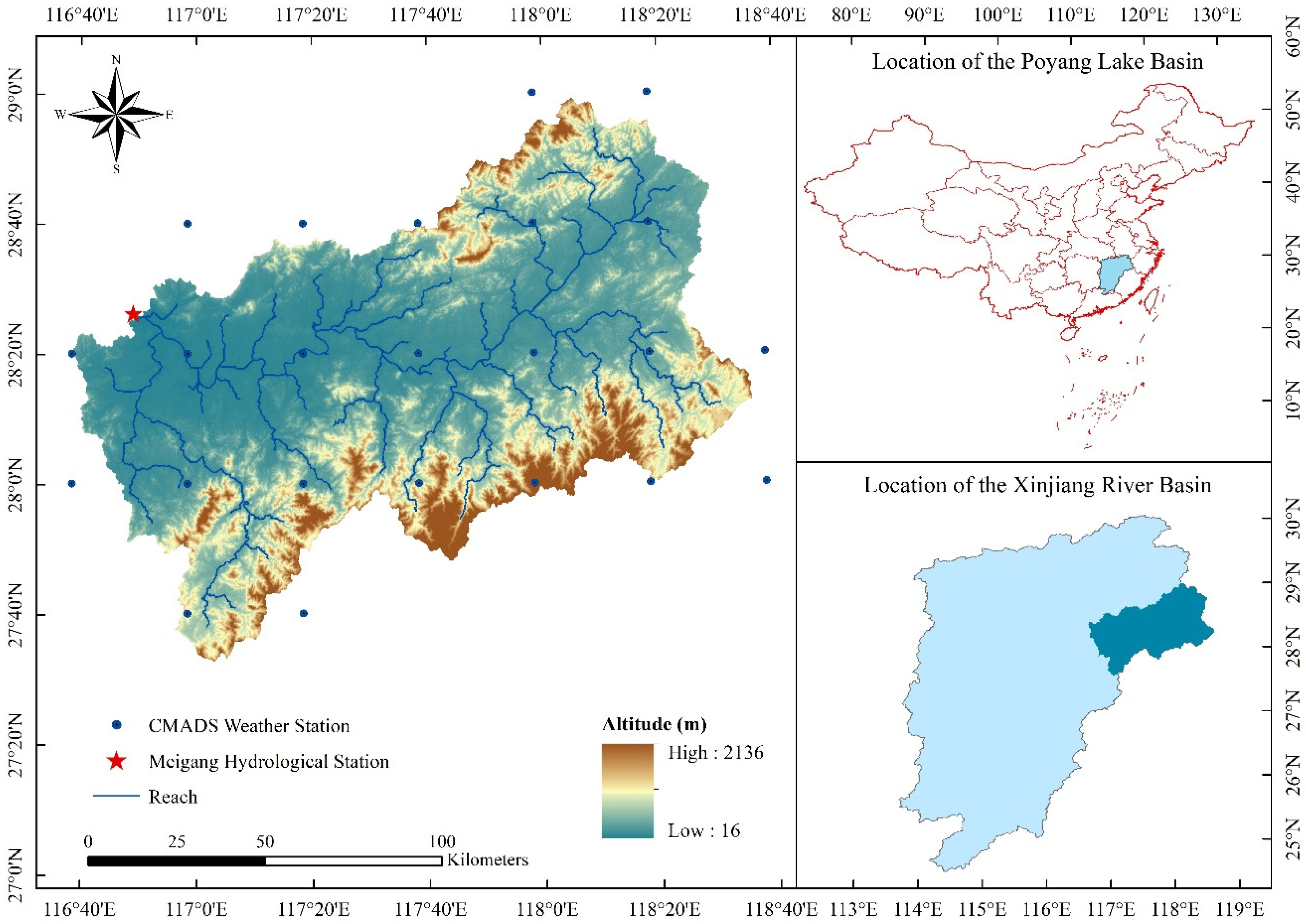

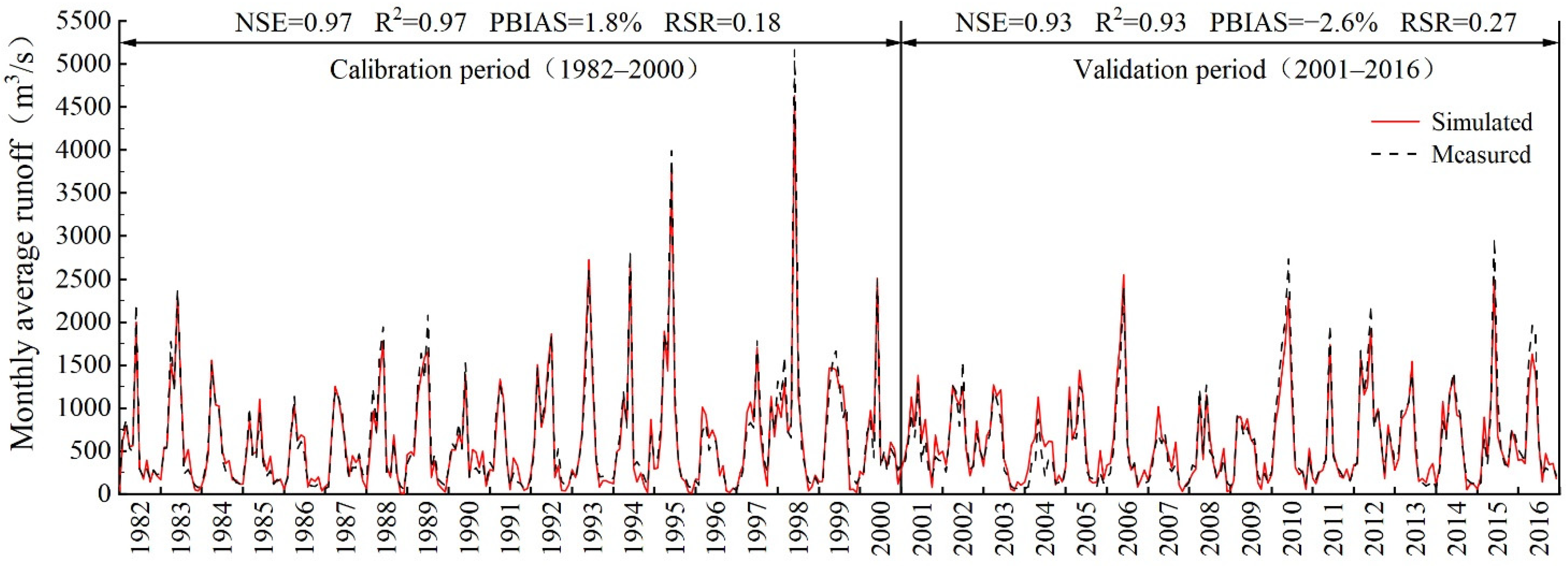
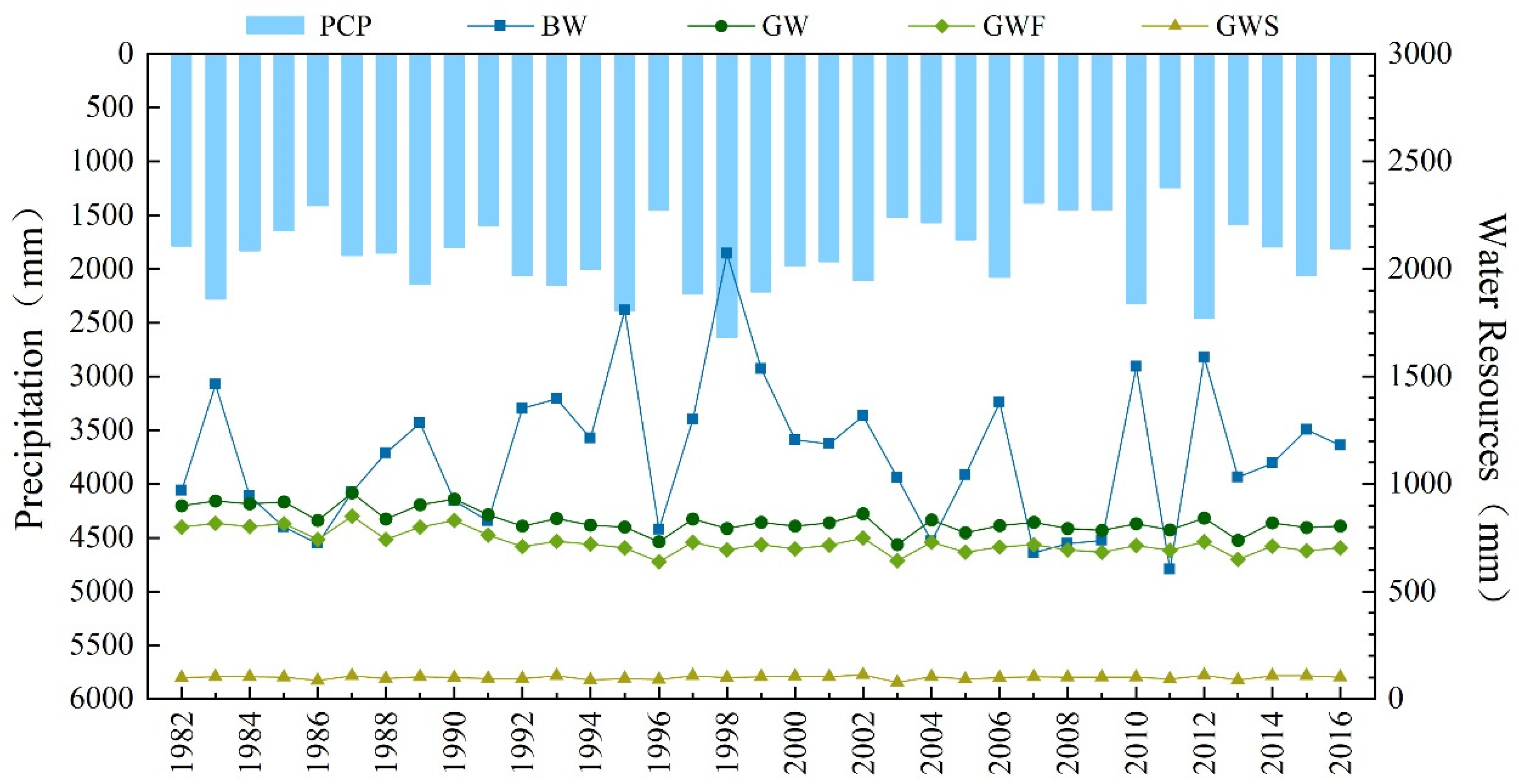
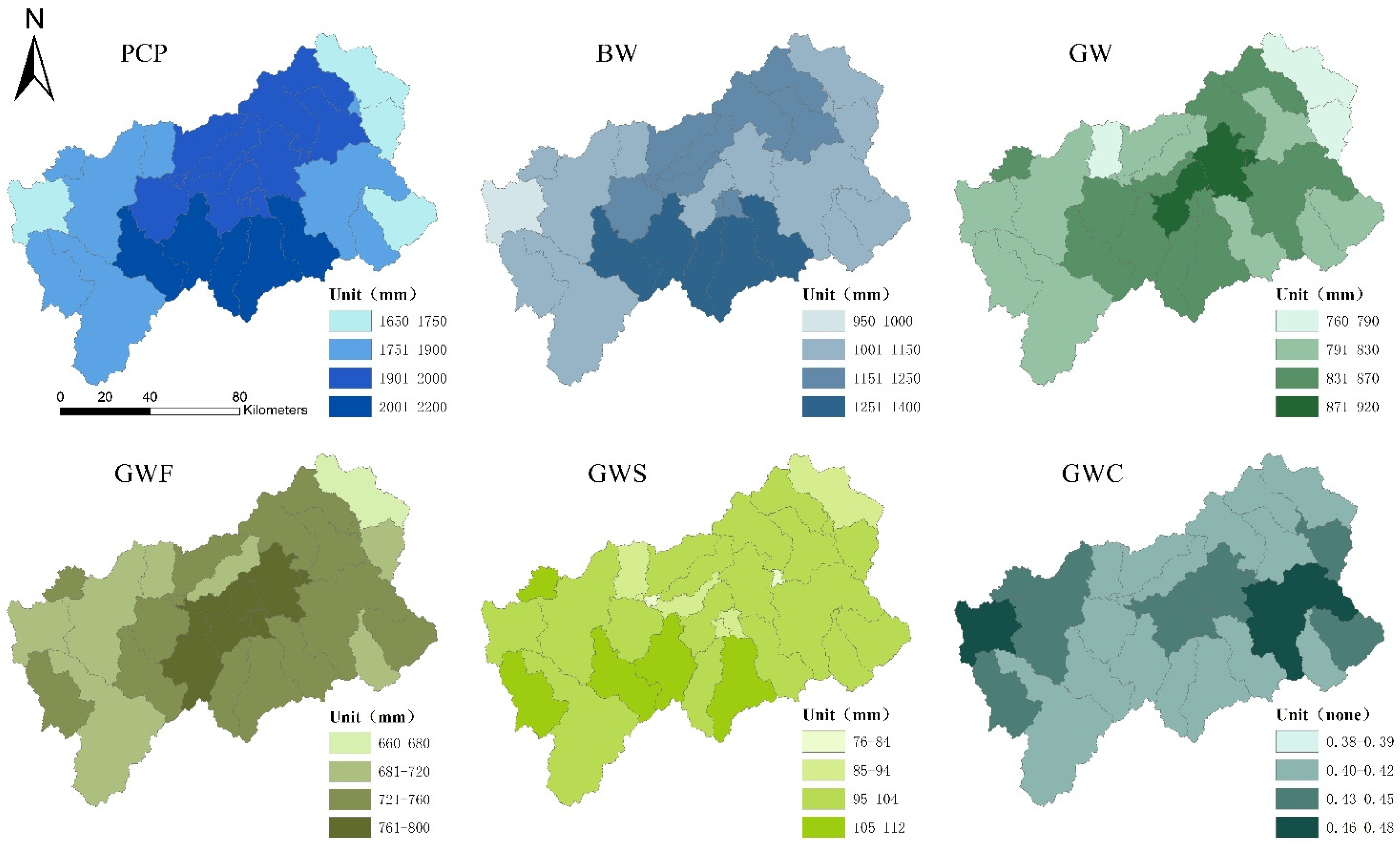


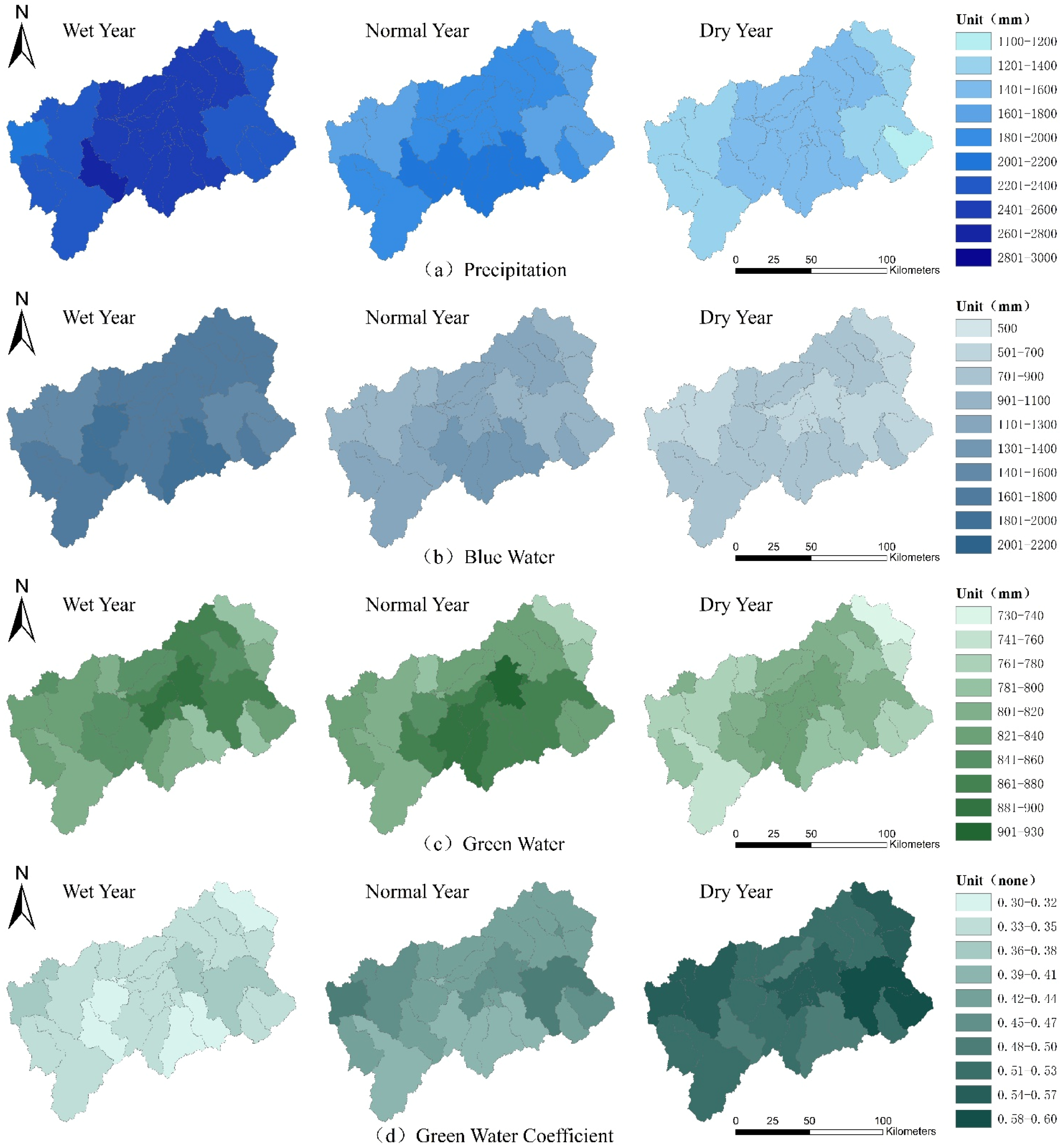



| Parameter Name | Parameter Meaning | T-Stat | p-Value | Final Value | Parameter Range |
|---|---|---|---|---|---|
| ALPHA_BNK | Base-flow factor | 16.441 | 0.000 | 0.338 | 0.234–0.374 |
| SFTMP | Snow melting temperature | −3.674 | 0.000 | −0.580 | −0.727–4.083 |
| CN2 | Number of SCS runoff curves under humid conditions | 1.727 | 0.084 | 0.546 | 0.464–0.642 |
| SMFMX | Maximum snow melt rate | 1.704 | 0.089 | 9.407 | 8.757–10.000 |
| ALPHA_BF | Base-flow coefficient | −1.686 | 0.092 | 0.617 | 0.484–0.628 |
| CH_K2 | Hydraulic conductivity of the main river channel | −1.664 | 0.096 | 49.476 | 41.883–50.000 |
| REVAPMN | Shallow groundwater depth for guaranteed evaporation | 1.491 | 0.136 | 303.279 | 272.57–398.68 |
| SMTMP | Snow melt accumulation temperature | −1.166 | 0.244 | −0.580 | −0.727–4.083 |
| SMFMN | Minimum snow melt factor | 0.951 | 0.342 | 2.391 | 1.734–3.773 |
| CH_N2 | Manning factor of the main river channel | 0.933 | 0.351 | 0.278 | 0.266–0.300 |
| OV_N | Manning factor for overland flow | −0.855 | 0.392 | 0.127 | −0.156–0.171 |
| GW_REVAP | Groundwater re-evaporation coefficient | −0.739 | 0.460 | 0.693 | 0.546–0.720 |
| Land Use Type | Plowland | Woodland | Grassland | Water Area | Construction Land | Bare Land | |
|---|---|---|---|---|---|---|---|
| 1990 | Area) | 3969.0 | 10,308.0 | 599.0 | 237.0 | 180.0 | 3.0 |
| Area proportion (%) | 25.95 | 67.39 | 3.92 | 1.55 | 1.18 | 0.02 | |
| 2010 | Area) | 3903.0 | 10,319.0 | 573.0 | 242.0 | 257.0 | 2.0 |
| Area proportion (%) | 25.52 | 67.46 | 3.75 | 1.58 | 1.68 | 0.01 | |
| Change amount ) | −66.0 | 11.0 | −26.0 | 5.0 | 77.0 | −1.0 | |
| Percentage of change area (%) | −0.43 | 0.07 | −0.17 | 0.03 | 0.50 | −0.01 | |
| Scenario Setting | Land Use Data | Meteorological Data |
|---|---|---|
| Scenario 1 | 1990 | 1979–2000 |
| Scenario 2 | 2010 | 1979–2000 |
| Scenario 3 | 2010 | 2001–2016 |
Publisher’s Note: MDPI stays neutral with regard to jurisdictional claims in published maps and institutional affiliations. |
© 2022 by the authors. Licensee MDPI, Basel, Switzerland. This article is an open access article distributed under the terms and conditions of the Creative Commons Attribution (CC BY) license (https://creativecommons.org/licenses/by/4.0/).
Share and Cite
Zhang, X.; Jiang, C.; Huang, J.; Ni, Z.; Sun, J.; Li, Z.; Wen, T. Spatiotemporal Evaluation of Blue and Green Water in Xinjiang River Basin Based on SWAT Model. Water 2022, 14, 2429. https://doi.org/10.3390/w14152429
Zhang X, Jiang C, Huang J, Ni Z, Sun J, Li Z, Wen T. Spatiotemporal Evaluation of Blue and Green Water in Xinjiang River Basin Based on SWAT Model. Water. 2022; 14(15):2429. https://doi.org/10.3390/w14152429
Chicago/Turabian StyleZhang, Xudong, Cong Jiang, Junzhe Huang, Zhenyu Ni, Jizhou Sun, Zuzhong Li, and Tianfu Wen. 2022. "Spatiotemporal Evaluation of Blue and Green Water in Xinjiang River Basin Based on SWAT Model" Water 14, no. 15: 2429. https://doi.org/10.3390/w14152429






